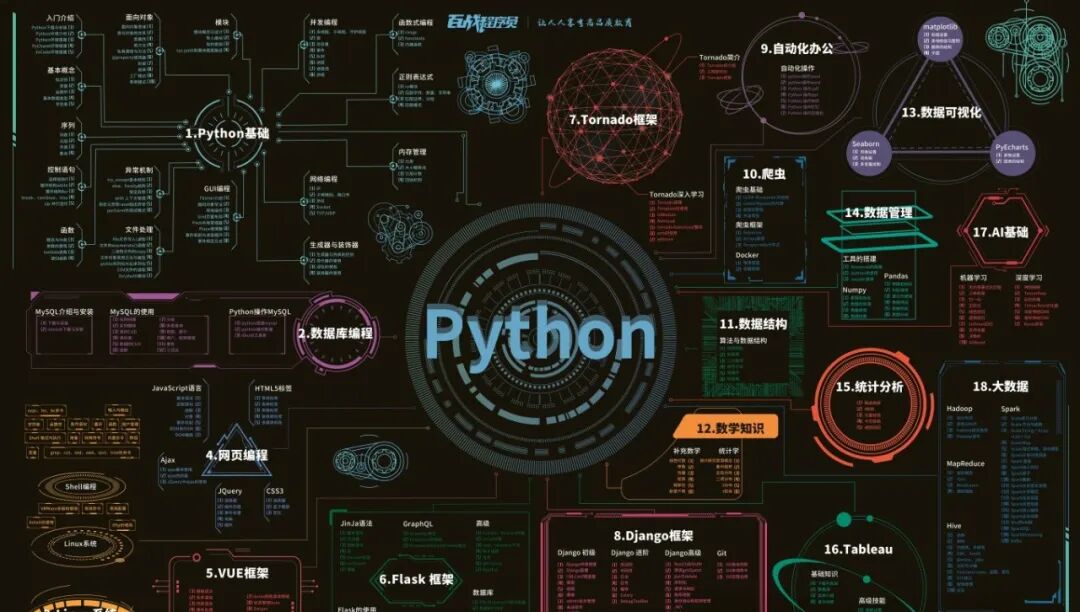
In 2025, Python programming has become an indispensable skill in many fields, whether it is data analysis, artificial intelligence, web development, or office automation, Python has demonstrated its powerful capabilities. Below is a detailed Python programming beginner’s guide to help you grow from a novice to an expert.
1. Basic Introduction
(1) Environment Setup
Select the appropriate version of Python for your operating system, download it from the official website, and install it while configuring the environment variables. It is recommended to use PyCharm or Jupyter as the integrated development environment, as they can greatly enhance development efficiency.
(2) Learning Syntax
Mastering the basic syntax of Python is key. Start with variables and data types, understanding the characteristics and usage of data types such as integers, floats, strings, lists, tuples, dictionaries, and sets. For example, define an integer variable <span>age = 20</span> and a string variable <span>name = "John"</span>. Next, learn control structures, including conditional statements (if – elif – else) and loops (for loops, while loops), and understand their working principles through simple examples, such as determining if a number is even.
(3) Function Definition and Usage
Learn to define functions, including parameter passing and return values. For example, define a function to calculate the sum of two numbers <span>def add_numbers(a, b): return a + b</span>, then call this function <span>result = add_numbers(5, 3)</span> and print the result.
2. Advanced Improvement
(1) Exploring Modules and Libraries
Python has a rich standard library and third-party libraries. Standard libraries such as the os module can be used for file and directory operations, and the math module can perform mathematical calculations. Third-party libraries like pandas are used for data analysis, and matplotlib for data visualization. Install the required libraries using the pip command and learn how to use them to solve practical problems.
(2) Object-Oriented Programming (OOP)
Understand the core concepts of OOP, including classes and objects, encapsulation, inheritance, and polymorphism. Create a class representing a student, define its attributes and methods, and then create a graduate class through inheritance, adding specific attributes and methods. Mastering OOP can enhance code reusability and maintainability.
3. In-Depth Learning
(1) Web Development
Understand the basic principles of the HTTP protocol, and master the concepts of routing systems and template engines. Using the Flask framework as an example, after installing Flask, create a simple web application to implement basic routing and page rendering functions. Deepen your learning of Django or Flask frameworks to develop web applications with practical functionalities, such as user authentication systems, database interactions, and page rendering.
(2) Advanced Data Analysis Techniques
Use pandas and numpy for complex data processing and analysis, such as data cleaning, feature engineering, and generating data analysis reports. Master the pandas dropna method to handle missing values, and use numpy for numerical calculations and matrix operations.
(3) Basic Machine Learning Algorithms
Get acquainted with basic machine learning algorithms, such as linear regression, logistic regression, and decision trees. Understand the principles and application scenarios of these algorithms, and learn how to implement them using Python’s machine learning libraries (such as scikit-learn) through practical cases.
4. Learning Resources and Methods
(1) Learning Resources
Select high-quality Python beginner tutorials, such as “Python Programming: From Beginner to Practice” and “Fluent Python,” as well as classic books or Python beginner courses on platforms like Bilibili and MOOC. At the same time, use online platforms (such as LeetCode and Niuke) to practice algorithm problems, enhancing algorithmic thinking and coding skills.
(2) Learning Methods
Programming learning emphasizes practice; be sure to follow the guidance of tutorials or books and complete the exercises at the end of each chapter. Try writing small scripts to solve simple practical problems, such as a calculator, temperature conversion tool, or number guessing game, to consolidate what you have learned. Additionally, analyze and learn from excellent Python code examples to understand their design ideas and implementation methods.
The journey of learning Python programming requires a gradual approach, from basic syntax to advanced applications, and then to in-depth learning and practice. As long as you persevere and continuously accumulate and improve, you can grow from a Python programming novice to an expert.